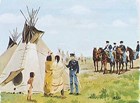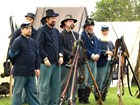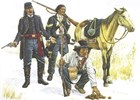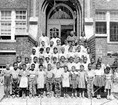The events that Fort Scott became involved in helped to transform the nation. From the Permanent Indian Frontier through westward expansion, Bleeding Kansas, the Civil War, and railroad development, the nation grew in both terms of size and character. The history of Fort Scott in each of these eras can be traced through these pages.
-
Fort Scott National Historic Site
Article 1: The Osage

Before the arrival of Europeans, the Osage Indians roamed a vast domain in the heart of North America. Although the Osage were a proud and powerful tribe, they could not withstand the pressure of European civilization. Soon after French fur trappers established contact with the Osages in the 1670s, their way of life began to change. Read more
-
Fort Scott National Historic Site
Article 2: Permanent Indian Frontier

Fort Scott was established to keep settlers in Missouri out of Indian Territory and to keep Native Americans out of Missouri. Soldiers acted as a border patrol to keep the two groups separated. Initially, the soldiers' job was to enforce the promise of a "permanent" Indian territory. Read more
-
Fort Scott National Historic Site
Article 3: Dragoon Expeditions in the 1840s

Fort Scott was established to contain Westward Expansion, yet many actions soldiers took had the opposite effect. From 1843-45, dragoons went out each summer to patrol the Oregon and Santa Fe Trails to make them safe for travel. They met with Native American tribes, had a showdown with Texans, and made it as far west as South Pass in Wyoming where they spent a few tense days near Oregon Territory in the event of a war with Great Britain. Read more
-
Fort Scott National Historic Site
Article 4: A Hearty Grip: Fort Scott Soldiers in the Mexican- American War

Imagine the fear you might have marching into battle with guns blazing all around you. Imagine the courage it took to charge an enemy when their cannons thundered at you from a fortified hilltop. Imagine fighting in a foreign country far from home against a determined foe and waging a war that half of your country opposes. Imagine putting your life in danger on a daily basis. Such was the experience of Fort Scott soldiers during the Mexican-American War. Read more
-
Fort Scott National Historic Site
Article 5: Bleeding Kansas: A Stain on Kansas History

In the 1850s, conflict arose over whether Kansas should be a free or slave state. People who felt strongly about the issue from all perspectives converged on Kansas Territory. Compromise was elusive as people on both sides employed violence to bring about their ends. Read more
-
Fort Scott National Historic Site
Article 6: Fort Scott in the Civil War

Fort Scott served as an important logistical and supply center for Union troops during the Civil War. On the grounds of the site, Union soldiers were mustered into the army, received supplies, provided medical care, and were disciplined. Fort Scott saw no battles, yet it played a vital role in contributing to the survival and success of Union soldiers. Read more
-
Fort Scott National Historic Site
Article 7: First to Serve-1st Kansas Colored Infantry Regiment

The 1st Kansas Colored Infantry first saw combat at the Battle of Island Mound in Missouri on October 29, 1862. In this skirmish, roughly 225 Black troops drove off 500 Confederate guerrillas. Richard Hinton, the 1st Kansas Colored Infantry adjutant, had this to say on the 1st Kansas Colored's victory at Island Mound, "The men fought like tigers, each and every one of them, and the main difficulty was to hold them all well in hand." Read more
-
Fort Scott National Historic Site
Article 8: Forgotten Warriors: American Indian Home Guard

There's no place like home! To Native Americans suffering in barren refugee camps in eastern Kansas during the Civil War, thoughts of home must have crossed their minds as they longed for the warmth and security of a home in Indian Territory (Oklahoma). While some could remember when home was elsewhere, after more than two decades, many had come to regard Indian Territory as home. Read more
-
Fort Scott National Historic Site
Article 9: Soldier vs. Settler: Railroads in Southeast Kansas

The first railroad came to Fort Scott in 1869. As it built south, it cut through land already inhabited by squatters who had not yet legally staked their claims. Settlers attacked, and the US Army sent in soldiers to protect the railroad. How would you feel if someone tried to take land that you were living on? Read more
-
Fort Scott National Historic Site
Article 10: Free To Learn: African American Schools in Fort Scott

The passage of the 13th Amendment ended slavery in the United States, but it did not immediately lead to opportunity and equality. Education was key to helping students succeed. From the end of the Civil War until the 1950s when schools were integrated, four Fort Scott African American schools did their best to provide opportunities for their students. Read more
